ELE5TDE Project: Planning, Simulation, Evaluation LTE-A Radio Network
VerifiedAdded on 2023/04/26
|9
|1794
|96
Project
AI Summary
This document presents a student project focused on the planning, simulation, and evaluation of an LTE-A (Long-Term Evolution Advanced) radio access network. The project, undertaken as part of the ELE5TDE course at La Trobe University, utilizes the CelPlanner software tool to simulate and analyze the performance of a 4G mobile network. The project outlines the objectives, including planning, simulation, and performance evaluation of 4G LTE-A technology, the use of CelPlanner, analysis of radio channel frequency response, and selection of a specific service area. The student's responsibilities included network planning, performance evaluation, and simulation using CelPlanner. The project details the methodology, including system parameter selection, path loss model implementation, service area configuration, and radio site configuration. It also addresses challenges encountered, such as frequency channel allocation and traffic capacity analysis, and the solutions implemented. The results of the simulation, including downstream and upstream composite predictions, are presented, demonstrating the optimization of RF coverage based on the morphology and topography of the service region.
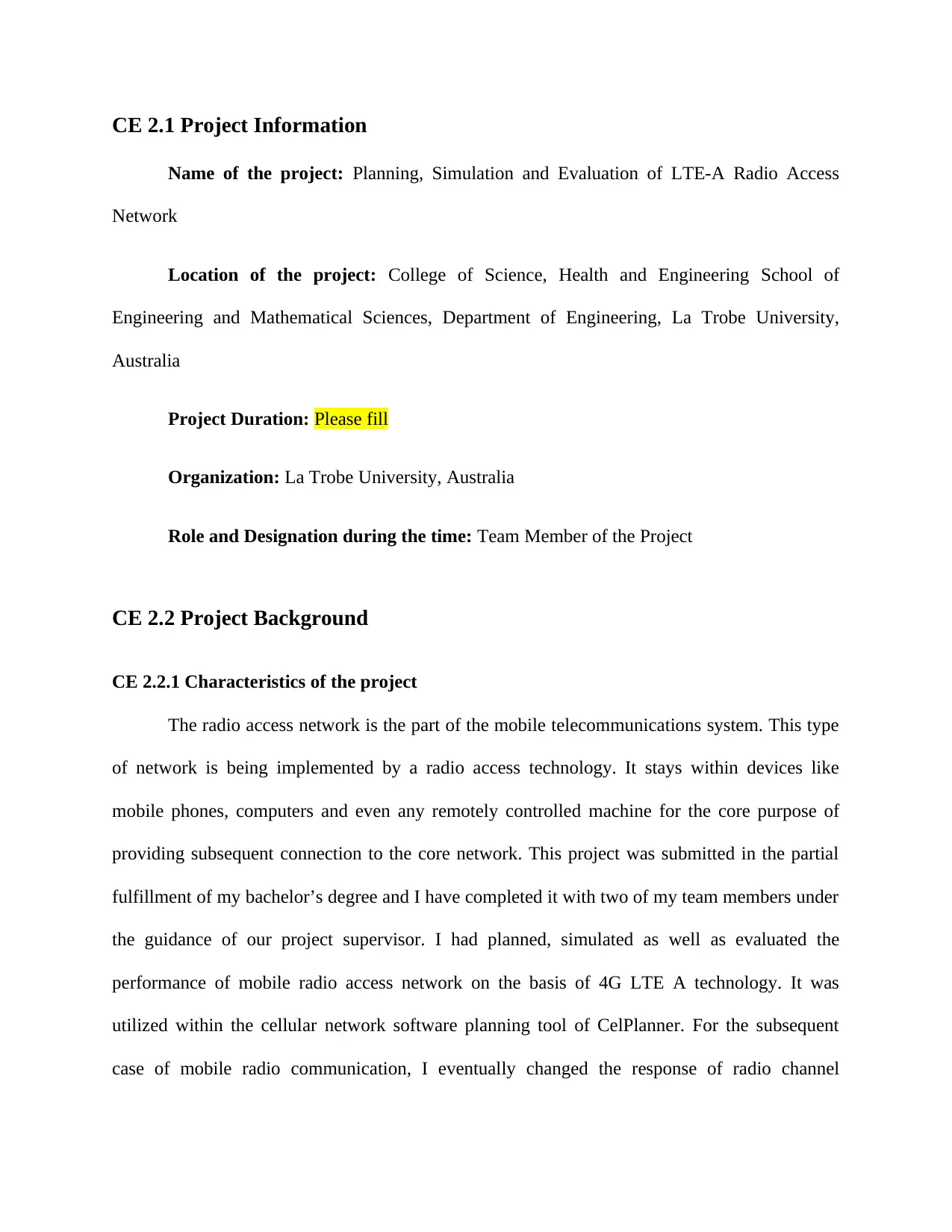
CE 2.1 Project Information
Name of the project: Planning, Simulation and Evaluation of LTE-A Radio Access
Network
Location of the project: College of Science, Health and Engineering School of
Engineering and Mathematical Sciences, Department of Engineering, La Trobe University,
Australia
Project Duration: Please fill
Organization: La Trobe University, Australia
Role and Designation during the time: Team Member of the Project
CE 2.2 Project Background
CE 2.2.1 Characteristics of the project
The radio access network is the part of the mobile telecommunications system. This type
of network is being implemented by a radio access technology. It stays within devices like
mobile phones, computers and even any remotely controlled machine for the core purpose of
providing subsequent connection to the core network. This project was submitted in the partial
fulfillment of my bachelor’s degree and I have completed it with two of my team members under
the guidance of our project supervisor. I had planned, simulated as well as evaluated the
performance of mobile radio access network on the basis of 4G LTE A technology. It was
utilized within the cellular network software planning tool of CelPlanner. For the subsequent
case of mobile radio communication, I eventually changed the response of radio channel
Name of the project: Planning, Simulation and Evaluation of LTE-A Radio Access
Network
Location of the project: College of Science, Health and Engineering School of
Engineering and Mathematical Sciences, Department of Engineering, La Trobe University,
Australia
Project Duration: Please fill
Organization: La Trobe University, Australia
Role and Designation during the time: Team Member of the Project
CE 2.2 Project Background
CE 2.2.1 Characteristics of the project
The radio access network is the part of the mobile telecommunications system. This type
of network is being implemented by a radio access technology. It stays within devices like
mobile phones, computers and even any remotely controlled machine for the core purpose of
providing subsequent connection to the core network. This project was submitted in the partial
fulfillment of my bachelor’s degree and I have completed it with two of my team members under
the guidance of our project supervisor. I had planned, simulated as well as evaluated the
performance of mobile radio access network on the basis of 4G LTE A technology. It was
utilized within the cellular network software planning tool of CelPlanner. For the subsequent
case of mobile radio communication, I eventually changed the response of radio channel
Paraphrase This Document
Need a fresh take? Get an instant paraphrase of this document with our AI Paraphraser

frequency for checking its stability. Hence, in the project, I had successfully exercised in the
telecommunication designing, which entailed planning, simulation and performance evaluation
of 4G LTE A technology after considering each and every technical specification.
CE 2.2.2 Objectives developed for the project
I have maintained a distinctive sequential manner in my project of LTE A radio access
network technology and have followed all types of standards and specifications. Hence, for the
purpose of completing this project eventually and then simulate and evaluate the respective
performances of this long term evaluation advanced technology and then making it extremely
effective and efficient, I have eventually developed these objectives given below:
To properly plan, simulate as well as evaluate the performance of mobile radio access
networks on the basis of 4G long term evolution advanced technology.
To utilize the most popular and significant cellular network software planning tool of
CelPlanner to simulate the project work.
To check the various changes within the radio channel frequency response for
understanding it to be highly statistical.
To choose a specific service area for checking the effectiveness and efficiency of my
project.
To follow a sequential manner in the project so that execution is much easier in
comparison to the others.
To contrast and analyze my experimental results with my evaluated theoretical outcomes
of the project.
telecommunication designing, which entailed planning, simulation and performance evaluation
of 4G LTE A technology after considering each and every technical specification.
CE 2.2.2 Objectives developed for the project
I have maintained a distinctive sequential manner in my project of LTE A radio access
network technology and have followed all types of standards and specifications. Hence, for the
purpose of completing this project eventually and then simulate and evaluate the respective
performances of this long term evaluation advanced technology and then making it extremely
effective and efficient, I have eventually developed these objectives given below:
To properly plan, simulate as well as evaluate the performance of mobile radio access
networks on the basis of 4G long term evolution advanced technology.
To utilize the most popular and significant cellular network software planning tool of
CelPlanner to simulate the project work.
To check the various changes within the radio channel frequency response for
understanding it to be highly statistical.
To choose a specific service area for checking the effectiveness and efficiency of my
project.
To follow a sequential manner in the project so that execution is much easier in
comparison to the others.
To contrast and analyze my experimental results with my evaluated theoretical outcomes
of the project.
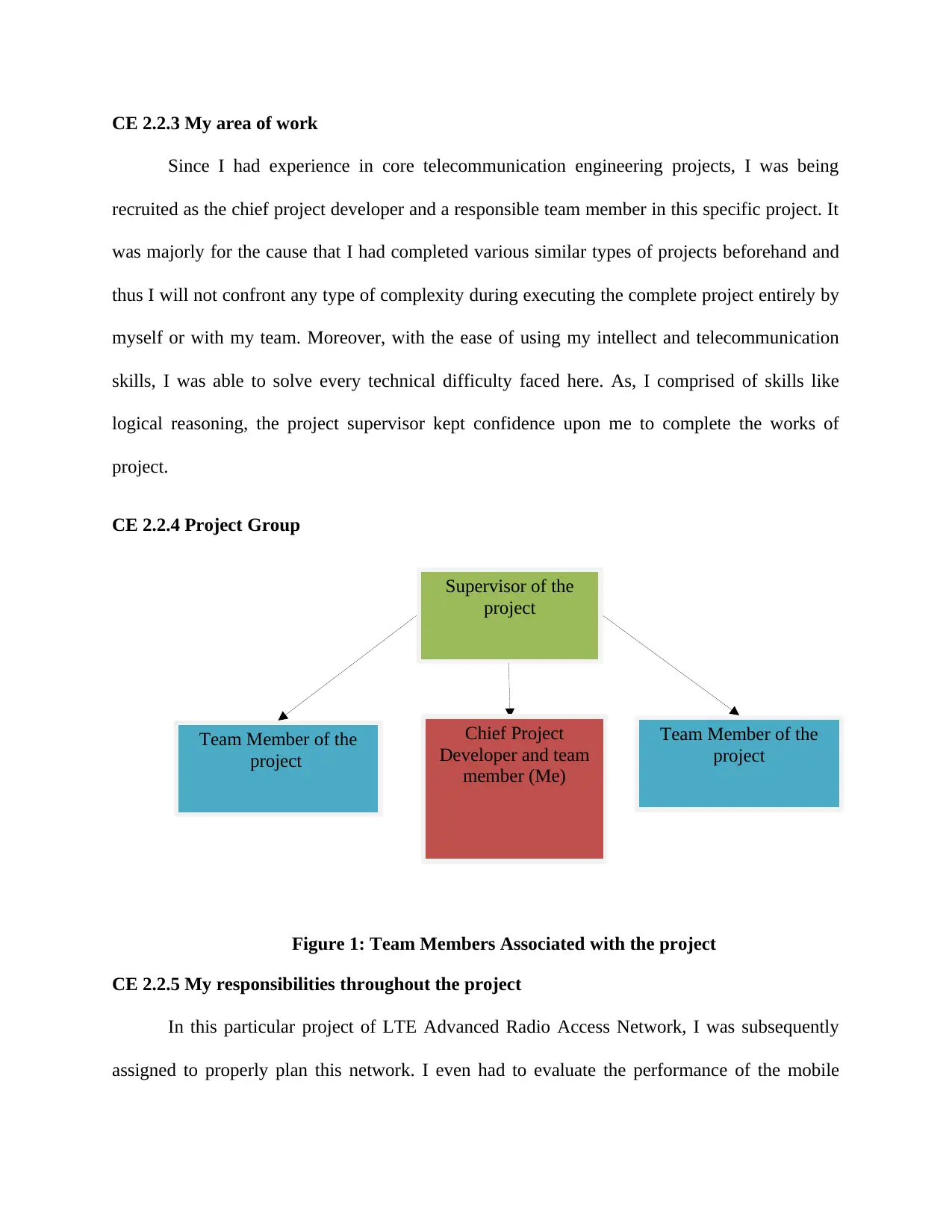
Supervisor of the
project
Chief Project
Developer and team
member (Me)
Team Member of the
project
Team Member of the
project
CE 2.2.3 My area of work
Since I had experience in core telecommunication engineering projects, I was being
recruited as the chief project developer and a responsible team member in this specific project. It
was majorly for the cause that I had completed various similar types of projects beforehand and
thus I will not confront any type of complexity during executing the complete project entirely by
myself or with my team. Moreover, with the ease of using my intellect and telecommunication
skills, I was able to solve every technical difficulty faced here. As, I comprised of skills like
logical reasoning, the project supervisor kept confidence upon me to complete the works of
project.
CE 2.2.4 Project Group
Figure 1: Team Members Associated with the project
CE 2.2.5 My responsibilities throughout the project
In this particular project of LTE Advanced Radio Access Network, I was subsequently
assigned to properly plan this network. I even had to evaluate the performance of the mobile
project
Chief Project
Developer and team
member (Me)
Team Member of the
project
Team Member of the
project
CE 2.2.3 My area of work
Since I had experience in core telecommunication engineering projects, I was being
recruited as the chief project developer and a responsible team member in this specific project. It
was majorly for the cause that I had completed various similar types of projects beforehand and
thus I will not confront any type of complexity during executing the complete project entirely by
myself or with my team. Moreover, with the ease of using my intellect and telecommunication
skills, I was able to solve every technical difficulty faced here. As, I comprised of skills like
logical reasoning, the project supervisor kept confidence upon me to complete the works of
project.
CE 2.2.4 Project Group
Figure 1: Team Members Associated with the project
CE 2.2.5 My responsibilities throughout the project
In this particular project of LTE Advanced Radio Access Network, I was subsequently
assigned to properly plan this network. I even had to evaluate the performance of the mobile
⊘ This is a preview!⊘
Do you want full access?
Subscribe today to unlock all pages.

Trusted by 1+ million students worldwide

radio access network on the basis of 4G long term evolution technology. My other
responsibilities included simulated the radio access network with the help of the software
planning tool of CelPlanner. I also evaluated the total performances of this specific network. I
ensured that in this project, the cellular mobile network was being preceded by our selected area
survey. I even checked the system parameters for enabling the morphology or topography after
setting up of frequency table for allocating channels within the individual cells. I also had to
select path loss model II of Korowajczuk and then completed respective morphology.
CE 2.3 Distinctive Activity
CE 2.3.1 Comprehending the Theory of the Project
The major theories of telecommunication engineering, which I had considered within the
project were the working principle of LTE radio access network. The long term evolution was
majorly developed only an internal 3GPP name for the subsequent program for enhancing
various capabilities of the 3G radio network. I have followed some of the most significant
methods in this project for all the categories of my project. In the beginning, I selected the
system as well as prediction parameters. I selected the geographic location of 32030’00.0”N and
32020’00.0”N for North and South respectively and 093030’00.0”W and 093030’00.0”W for East
and West respectively.
responsibilities included simulated the radio access network with the help of the software
planning tool of CelPlanner. I also evaluated the total performances of this specific network. I
ensured that in this project, the cellular mobile network was being preceded by our selected area
survey. I even checked the system parameters for enabling the morphology or topography after
setting up of frequency table for allocating channels within the individual cells. I also had to
select path loss model II of Korowajczuk and then completed respective morphology.
CE 2.3 Distinctive Activity
CE 2.3.1 Comprehending the Theory of the Project
The major theories of telecommunication engineering, which I had considered within the
project were the working principle of LTE radio access network. The long term evolution was
majorly developed only an internal 3GPP name for the subsequent program for enhancing
various capabilities of the 3G radio network. I have followed some of the most significant
methods in this project for all the categories of my project. In the beginning, I selected the
system as well as prediction parameters. I selected the geographic location of 32030’00.0”N and
32020’00.0”N for North and South respectively and 093030’00.0”W and 093030’00.0”W for East
and West respectively.
Paraphrase This Document
Need a fresh take? Get an instant paraphrase of this document with our AI Paraphraser

Figure 2: Screenshot of Selected Topography of the project
The System Parameters interface helped me in enabling the topography or morphology
and then set up the respective frequency table for helping up in allocation of channels to the
individual sets. For this particular case, I have set it to GSM 39. I even selected the subsequent
path loss model of Korowajczuk and then completed the major morphology for attaining path
attenuation and path loss. It is the proper reduction of power density that is nothing but the
attenuation of electro magnetic wave when it is being propagating through space.
The System Parameters interface helped me in enabling the topography or morphology
and then set up the respective frequency table for helping up in allocation of channels to the
individual sets. For this particular case, I have set it to GSM 39. I even selected the subsequent
path loss model of Korowajczuk and then completed the major morphology for attaining path
attenuation and path loss. It is the proper reduction of power density that is nothing but the
attenuation of electro magnetic wave when it is being propagating through space.

Figure 3: Screenshot of Path Loss Model of Korowajczuk
CE 2.3.2 Engineering knowledge and skills applied in the project
The major engineering knowledge and skill that I have applied in this particular project
was the working principle of 4G advanced long term evolution radio access network and digital
communication. I also have applied my knowledge of electronic devices and circuits as well as
signals and systems. Moreover, with my familiarity with the communication systems, it was
quite easy for me to complete the task without much complexity. To simulate the project work, I
have used my knowledge of CelPlanner software simulation tool. Furthermore, my capability of
thinking out of the box was one of the core advantage in this project.
CE 2.3.2 Engineering knowledge and skills applied in the project
The major engineering knowledge and skill that I have applied in this particular project
was the working principle of 4G advanced long term evolution radio access network and digital
communication. I also have applied my knowledge of electronic devices and circuits as well as
signals and systems. Moreover, with my familiarity with the communication systems, it was
quite easy for me to complete the task without much complexity. To simulate the project work, I
have used my knowledge of CelPlanner software simulation tool. Furthermore, my capability of
thinking out of the box was one of the core advantage in this project.
⊘ This is a preview!⊘
Do you want full access?
Subscribe today to unlock all pages.

Trusted by 1+ million students worldwide
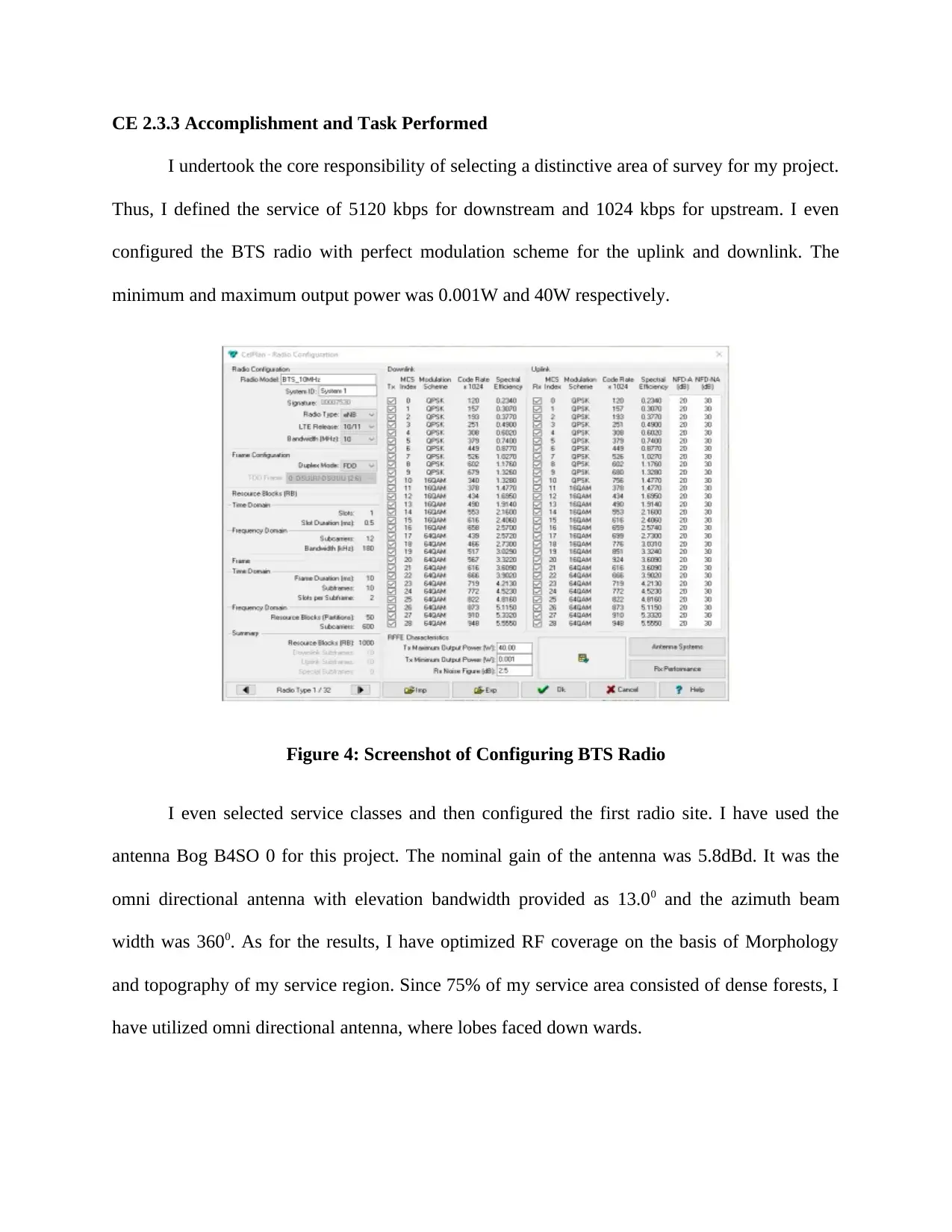
CE 2.3.3 Accomplishment and Task Performed
I undertook the core responsibility of selecting a distinctive area of survey for my project.
Thus, I defined the service of 5120 kbps for downstream and 1024 kbps for upstream. I even
configured the BTS radio with perfect modulation scheme for the uplink and downlink. The
minimum and maximum output power was 0.001W and 40W respectively.
Figure 4: Screenshot of Configuring BTS Radio
I even selected service classes and then configured the first radio site. I have used the
antenna Bog B4SO 0 for this project. The nominal gain of the antenna was 5.8dBd. It was the
omni directional antenna with elevation bandwidth provided as 13.00 and the azimuth beam
width was 3600. As for the results, I have optimized RF coverage on the basis of Morphology
and topography of my service region. Since 75% of my service area consisted of dense forests, I
have utilized omni directional antenna, where lobes faced down wards.
I undertook the core responsibility of selecting a distinctive area of survey for my project.
Thus, I defined the service of 5120 kbps for downstream and 1024 kbps for upstream. I even
configured the BTS radio with perfect modulation scheme for the uplink and downlink. The
minimum and maximum output power was 0.001W and 40W respectively.
Figure 4: Screenshot of Configuring BTS Radio
I even selected service classes and then configured the first radio site. I have used the
antenna Bog B4SO 0 for this project. The nominal gain of the antenna was 5.8dBd. It was the
omni directional antenna with elevation bandwidth provided as 13.00 and the azimuth beam
width was 3600. As for the results, I have optimized RF coverage on the basis of Morphology
and topography of my service region. Since 75% of my service area consisted of dense forests, I
have utilized omni directional antenna, where lobes faced down wards.
Paraphrase This Document
Need a fresh take? Get an instant paraphrase of this document with our AI Paraphraser
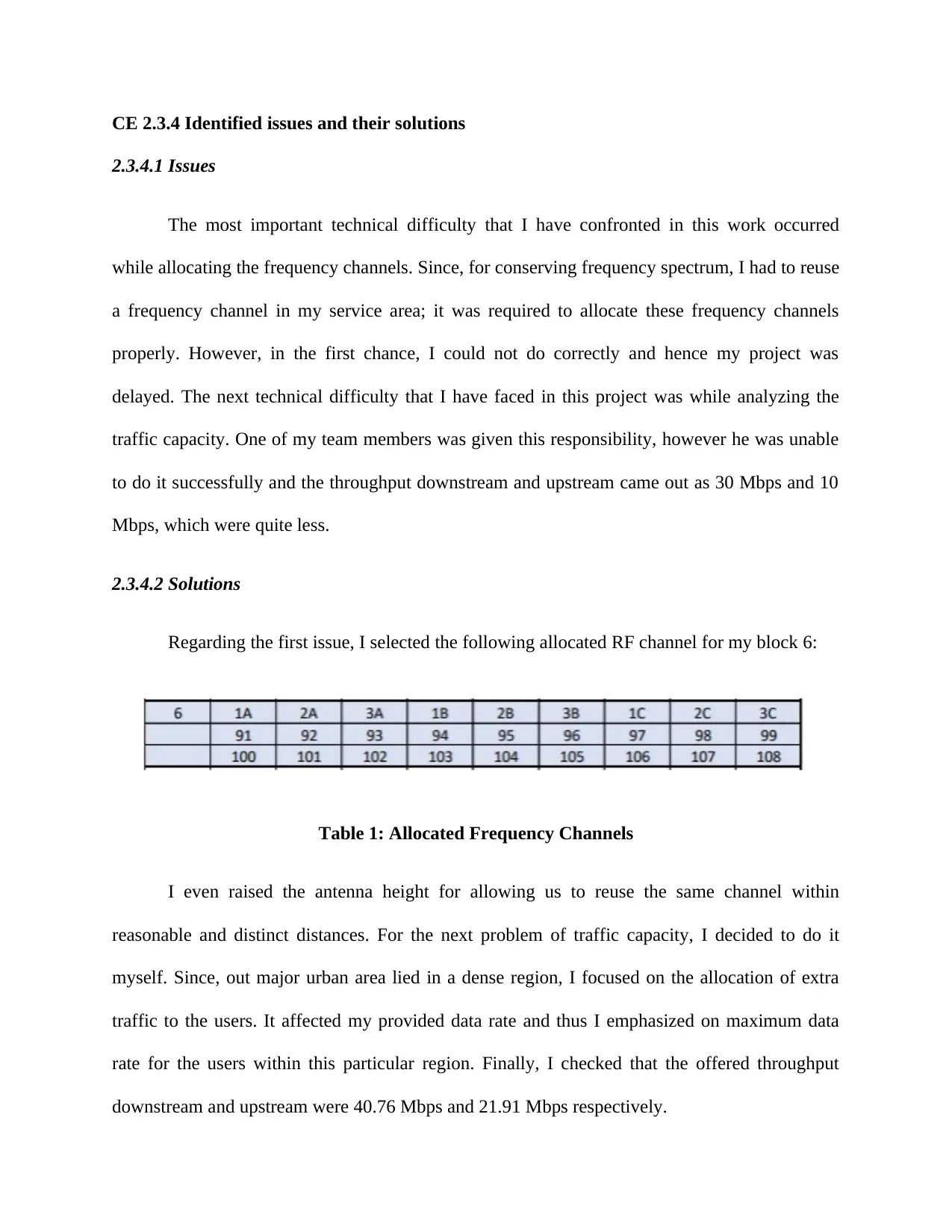
CE 2.3.4 Identified issues and their solutions
2.3.4.1 Issues
The most important technical difficulty that I have confronted in this work occurred
while allocating the frequency channels. Since, for conserving frequency spectrum, I had to reuse
a frequency channel in my service area; it was required to allocate these frequency channels
properly. However, in the first chance, I could not do correctly and hence my project was
delayed. The next technical difficulty that I have faced in this project was while analyzing the
traffic capacity. One of my team members was given this responsibility, however he was unable
to do it successfully and the throughput downstream and upstream came out as 30 Mbps and 10
Mbps, which were quite less.
2.3.4.2 Solutions
Regarding the first issue, I selected the following allocated RF channel for my block 6:
Table 1: Allocated Frequency Channels
I even raised the antenna height for allowing us to reuse the same channel within
reasonable and distinct distances. For the next problem of traffic capacity, I decided to do it
myself. Since, out major urban area lied in a dense region, I focused on the allocation of extra
traffic to the users. It affected my provided data rate and thus I emphasized on maximum data
rate for the users within this particular region. Finally, I checked that the offered throughput
downstream and upstream were 40.76 Mbps and 21.91 Mbps respectively.
2.3.4.1 Issues
The most important technical difficulty that I have confronted in this work occurred
while allocating the frequency channels. Since, for conserving frequency spectrum, I had to reuse
a frequency channel in my service area; it was required to allocate these frequency channels
properly. However, in the first chance, I could not do correctly and hence my project was
delayed. The next technical difficulty that I have faced in this project was while analyzing the
traffic capacity. One of my team members was given this responsibility, however he was unable
to do it successfully and the throughput downstream and upstream came out as 30 Mbps and 10
Mbps, which were quite less.
2.3.4.2 Solutions
Regarding the first issue, I selected the following allocated RF channel for my block 6:
Table 1: Allocated Frequency Channels
I even raised the antenna height for allowing us to reuse the same channel within
reasonable and distinct distances. For the next problem of traffic capacity, I decided to do it
myself. Since, out major urban area lied in a dense region, I focused on the allocation of extra
traffic to the users. It affected my provided data rate and thus I emphasized on maximum data
rate for the users within this particular region. Finally, I checked that the offered throughput
downstream and upstream were 40.76 Mbps and 21.91 Mbps respectively.
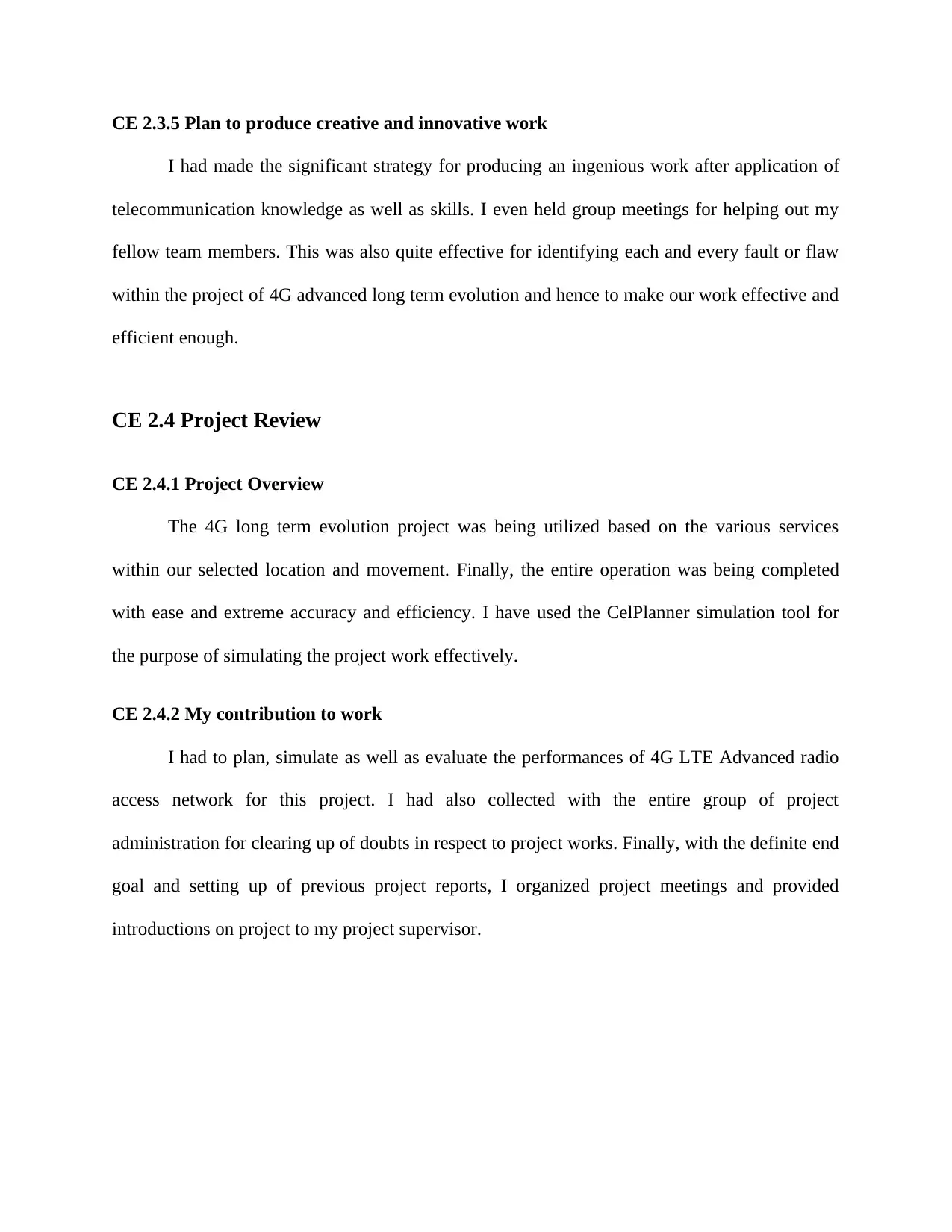
CE 2.3.5 Plan to produce creative and innovative work
I had made the significant strategy for producing an ingenious work after application of
telecommunication knowledge as well as skills. I even held group meetings for helping out my
fellow team members. This was also quite effective for identifying each and every fault or flaw
within the project of 4G advanced long term evolution and hence to make our work effective and
efficient enough.
CE 2.4 Project Review
CE 2.4.1 Project Overview
The 4G long term evolution project was being utilized based on the various services
within our selected location and movement. Finally, the entire operation was being completed
with ease and extreme accuracy and efficiency. I have used the CelPlanner simulation tool for
the purpose of simulating the project work effectively.
CE 2.4.2 My contribution to work
I had to plan, simulate as well as evaluate the performances of 4G LTE Advanced radio
access network for this project. I had also collected with the entire group of project
administration for clearing up of doubts in respect to project works. Finally, with the definite end
goal and setting up of previous project reports, I organized project meetings and provided
introductions on project to my project supervisor.
I had made the significant strategy for producing an ingenious work after application of
telecommunication knowledge as well as skills. I even held group meetings for helping out my
fellow team members. This was also quite effective for identifying each and every fault or flaw
within the project of 4G advanced long term evolution and hence to make our work effective and
efficient enough.
CE 2.4 Project Review
CE 2.4.1 Project Overview
The 4G long term evolution project was being utilized based on the various services
within our selected location and movement. Finally, the entire operation was being completed
with ease and extreme accuracy and efficiency. I have used the CelPlanner simulation tool for
the purpose of simulating the project work effectively.
CE 2.4.2 My contribution to work
I had to plan, simulate as well as evaluate the performances of 4G LTE Advanced radio
access network for this project. I had also collected with the entire group of project
administration for clearing up of doubts in respect to project works. Finally, with the definite end
goal and setting up of previous project reports, I organized project meetings and provided
introductions on project to my project supervisor.
⊘ This is a preview!⊘
Do you want full access?
Subscribe today to unlock all pages.

Trusted by 1+ million students worldwide
1 out of 9
Related Documents
Your All-in-One AI-Powered Toolkit for Academic Success.
+13062052269
info@desklib.com
Available 24*7 on WhatsApp / Email
![[object Object]](/_next/static/media/star-bottom.7253800d.svg)
Unlock your academic potential
Copyright © 2020–2025 A2Z Services. All Rights Reserved. Developed and managed by ZUCOL.





